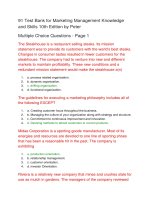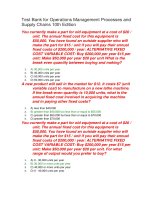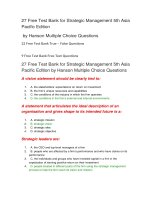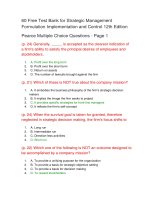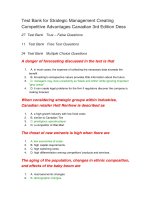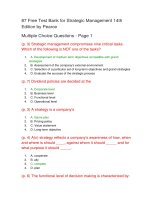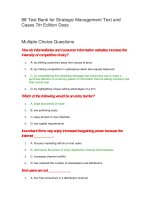Test bank for strategic management text and cases 6th edition dess
Bạn đang xem bản rút gọn của tài liệu. Xem và tải ngay bản đầy đủ của tài liệu tại đây (82.55 KB, 12 trang )
Test Bank for Strategic Management Text and Cases
6th Edition Dess
Multiple Choice Questions
(p. 49) Increasingly larger numbers of women entering the
work force since the early 1970s is an example of
1.
2.
3.
4.
A. demographic changes.
B. political and legal environmental changes.
C. sociocultural changes.
D. technological developments.
(p. 60) Exit barriers arise from
1.
2.
3.
4.
A. specialized assets with no alternative use.
B. governmental and social pressures.
C. strategic interrelationships with other business units within the same company.
D. all of these.
(p. 63) Supplier power has increased because of the Internet
for all of the following reasons EXCEPT
1.
A. the growth of new Web-based businesses has created more outlets for
suppliers to sell to.
2. B. some suppliers have created Web-based purchasing systems that encourage
switching.
3. C. the process of disintermediation makes it possible for some suppliers to reach
end users directly.
4. D. software that links buyers to a supplier's website has created rapid, low-cost
order capabilities.
(p. 59-60) Firms would be most likely to face intense rivalry
with competitors when they
1.
2.
3.
4.
A. are in a high growth industry with low fixed costs.
B. are in a protected market.
C. have high fixed costs, in a slow growth industry with high exit barriers.
D. have low exit barriers for easy transition to another industry.
(p. 55) A large fabricator of building components purchased
a steel company to provide raw materials for its
production process. This is an example of
1.
2.
3.
4.
A. backward integration.
B. economies of scale.
C. forward integration.
D. product differentiation.
(p. 61) Because the Internet lowers barriers to entry in most
industries, it
1.
2.
3.
4.
A. decreases the threat of new entrants.
B. increases the threat of new entrants.
C. makes it easier to build customer loyalty.
D. increases supplier power.
(p. 56) The threat of new entrants is high when there are
1.
2.
3.
4.
A. low economies of scale.
B. high capital requirements.
C. high switching costs.
D. high differentiation among competitors' products and services.
(p. 68-69) Which of the following statements about strategic
groups is FALSE?
1.
A. Two assumptions are made: (1) no two firms are totally different, (2) no two
firms are exactly the same.
2. B. Strategic groupings are of little help to a firm in assessing mobility barriers that
protect a group from attacks by other groups.
3. C. Strategic groups help chart the future directions of firms' strategies.
4. D. Strategic groups are helpful in thinking through the implications of each industry
trend for the group as a whole.
(p. 56) Product differentiation by incumbents act as an entry
barrier because
1.
2.
A. new entrants cannot differentiate their products.
B. incumbents will take legal action if new entrants do not differentiate their
products.
3. C. new entrants will have to spend heavily to overcome existing customer
loyalties.
4. D. it helps a firm to derive greater economies of scale.
(p. 67) The value net is a game-theoretic approach that
1.
2.
A. extends the value chain analysis.
B. is a way to analyze all the players in a game and analyze how their interactions
affect a firm's ability to generate and appropriate value.
3. C. helps us to understand the evolution of the five forces over time.
4. D. uses network analysis to understand the relationships among different
companies.
(p. 60) Which of the following firms would likely pose the
least competitive threat?
1.
2.
3.
A. A firm in the same industry and in the same strategic group.
B. A firm that produces substitute goods to your product line.
C. A competitor to your product where a high switching cost exists.
4.
D. A firm in the same industry and in the nearest strategic group looking to join
your group.
(p. 55) An independent group of suppliers, such as farmers,
gather to form a cooperative to sell their products to
buyers directly, replacing their former distributor. This
is an example of
1.
2.
3.
4.
A. threat of entry.
B. backward integration.
C. forward integration.
D. threat of substitute products.
(p. 45) A danger of forecasting discussed in the text is that
1.
A. in most cases, the expense of collecting the necessary data exceeds the
benefit.
2. B. forecasting's retrospective nature provides little information about the future.
3. C. managers may view uncertainty as "black and white" while ignoring important
"gray areas."
4. D. it can create legal problems for the firm if regulators discover the company is
making forecasts.
(p. 58-59) The bargaining power of suppliers is enhanced
under the following market condition:
1.
2.
3.
4.
A. no threat of forward integration.
B. low differentiation of the suppliers' products.
C. greater availability of substitute products.
D. dominance by a few suppliers.
(p. 41) Two of the key inputs to developing forecasts
discussed in the text are
1.
2.
3.
4.
A. environmental scanning and stakeholder identification.
B. environmental scanning and competitor intelligence.
C. assessing internal strengths and environmental scanning.
D. environmental scanning and a SWOT analysis.
(p. 55) Which is considered a force in the "Five-Forces"
model?
1.
2.
3.
4.
A. Increased deregulation in an industry.
B. The threat of government intervention.
C. Rivalry among competing firms.
D. Recent technological innovation.
(p. 59) Threat of substitute products comes from
1.
2.
A. other companies in the same industry.
B. foreign companies which can use cheap labor in their countries.
3.
C. firms in other industries that produce products or services that satisfy the same
customer need.
4. D. all of these.
(p. 56) Which of the following would be an entry barrier?
1.
2.
3.
4.
A. large economies of scale
B. low switching costs
C. easy access to raw materials
D. low capital requirements
(p. 64) In general, the threat of substitutes is heightened
because the Internet
1.
2.
3.
4.
A. introduces new ways to accomplish the same task.
B. lowers switching costs.
C. lowers barriers to entry.
D. increases output per unit of cost.
(p. 63) Incumbent firms may enjoy increased bargaining
power because the Internet
1.
2.
3.
4.
A. focuses marketing efforts on end users.
B. diminishes the power of many distribution channel intermediaries.
C. increases channel conflict.
D. has reduced the number of wholesalers and distributors.
(p. 65) How do infomediaries and consumer information
websites increase the intensity of competitive rivalry?
1.
2.
3.
A. by shifting customers away from issues of price
B. by making competitors in cyberspace seem less equally balanced
C. by consolidating the marketing message that consumers use to make a
purchase decision to a few key pieces of information that the selling company has
little control over
4. D. by highlighting a firm's unique selling advantages
(p. 58-59) In Porter's Five-Forces model, conditions under
which a supplier group can be powerful include all the
following EXCEPT
1.
2.
3.
4.
A. lack of importance of the buyer to the supplier group.
B. high differentiation by the supplier.
C. dominance by a few suppliers.
D. readily available substitute products.
(p. 67) In the value net analysis, complementors are
1.
2.
3.
A. firms that produce substitute products.
B. customers who compliment the company for their good products and services.
C. firms that produce products or services that have a positive impact on the value
of a firm's products or services.
4.
D. firms that supply critical inputs to a company.
(p. 47) The aging of the population, changes in ethnic
composition, and effects of the baby boom are
1.
2.
3.
4.
A. macroeconomic changes.
B. demographic changes.
C. global changes.
D. sociocultural changes.
(p. 63) End users are
1.
2.
3.
4.
A. the final consumers in a distribution channel.
B. usually the C in B2C.
C. likely to have greater bargaining power because of the Internet.
D. all of these.
(p. 49-50) Emerging sociocultural changes in the
environment include
1.
2.
3.
4.
A. changes in the ethnic composition.
B. the increasing educational attainment of women in the past decade.
C. progressively less disposable income by consumers.
D. changes in the geographic distribution of the population.
(p. 51) Interest-rate increases have a __________ impact on
the residential home construction industry and a
__________ effect on industries that produce
consumer necessities such as prescription drugs or
basic grocery items.
1.
2.
3.
4.
A. positive; negligible
B. negative; negligible
C. negative; positive
D. positive; negative
(p. 57) The bargaining power of the buyer is greater than that
of the supplier when
1.
2.
3.
4.
A. volume of purchase is low.
B. threat of backward integration by buyers is low.
C. cost savings from the supplier's product are minimal.
D. the buyer's profit margin is low.
(p. 59-60) The most intense rivalry results from
1.
A. numerous equally balanced competitors, slow industry growth, high fixed or
storage costs.
2. B. few competitors, slow industry growth, lack of differentiation, high fixed or
storage costs.
3.
C. numerous equally balanced competitors, manufacturing capacity increases only
in large increments, low exit barriers.
4. D. a high level of differentiation.
(p. 50) All of the following are important elements of the
political/legal segment of the general environment
EXCEPT
1.
2.
3.
4.
A. the deregulation of utilities.
B. the Americans with Disabilities Act (ADA).
C. the increased use of Internet technology.
D. increases in the federally mandated minimum wage.
(p. 58-59) A supplier group would be most powerful when
there is/are
1.
2.
3.
4.
A. many suppliers.
B. few substitute products.
C. low differentiation of products supplied.
D. high threat of backward integration by the buyers.
(p. 57) Buyer power will be greater when
1.
2.
3.
A. the products purchased are highly differentiated.
B. there are high switching costs.
C. the industry's product is very important to the quality of the buyer's end
products or services.
4. D. it is concentrated or purchases large volumes relative to seller sales.
(p. 44) Environmental forecasting involves developing
plausible projections about the ________ of
environmental change.
1.
2.
3.
4.
A. direction
B. scope
C. speed
D. all of these
(p. 58-59) The bargaining power of suppliers increases as
1.
2.
3.
4.
A. more suppliers enter the market.
B. importance of buyers to supplier group increases.
C. switching costs for buyers decrease.
D. threat of forward integration by suppliers increases.
(p. 68) Strategic groups consist of
1.
2.
3.
A. a group of top executives who make strategies for a company.
B. a group of firms within an industry that follow similar strategies.
C. a group of executives drawn from different companies within an industry that
makes decisions on industry standards.
4.
D. a group of firms within an industry that decide to collude rather than compete
with each other so that they can increase their profits.
(p. 42) _____________ tracks the evolution of environmental
trends, sequences of events, or streams of activities.
1.
2.
3.
4.
A. Environmental scanning
B. Environmental monitoring
C. Environmental surveying
D. Competitive intelligence
(p. 42) Gathering "competitive intelligence"
1.
2.
3.
4.
A. is good business practice.
B. is illegal.
C. is considered unethical.
D. minimizes the need to obtain information in the public domain.
(p. 41) Scanning the general environment would identify
information on
1.
2.
3.
4.
A. substitute goods.
B. the aging population and ethnic shifts.
C. customer and firm bargaining power.
D. competitive rivalry.
(p. 47) Which of the following would be considered part of a
firm's general environment?
1.
2.
3.
4.
A. Decreased entry barriers.
B. Higher unemployment rates.
C. Increased bargaining power of the firm's suppliers.
D. Increased competitive intensity.
(p. 51) To illustrate interrelationships among different
segments of the general environment: The persistence
of large U.S. trade deficits (__________) has led to
greater demand for protectionist measures, such as
trade barriers and quotas (__________). These
measures lead to higher prices for U.S. consumers and
fuel inflation (__________).
1.
2.
3.
4.
A. macroeconomic, sociocultural, political/legal
B. macroeconomic, political/legal, economic
C. macroeconomic, technological, economic
D. macroeconomic, global, economic
True - False Questions
(p. 63) Because of the Internet and digital technologies, it is
very difficult for suppliers to create purchasing
techniques that lower switching costs.
1.
2.
True
False
(p. 69-70) The same environmental trend or event may have a
very different impact on different strategic groups
within the same industry.
1.
2.
True
False
(p. 61) The Internet and digital technologies suppress the
bargaining power of buyers by providing them with
more information to make buying decisions.
1.
2.
True
False
(p. 56) In some industries, high switching costs can act as an
important barrier to entry.
1.
2.
True
False
(p. 56) Industries characterized by high economies of scale
typically attract fewer new entrants.
1.
2.
True
False
(p. 44) Even with all of the advances in recent years,
forecasting is typically considered more of an art than
a science and it is of little use in generating accurate
predictions.
1.
2.
True
False
(p. 70) The strategic groups in the world-wide automobile
industry have been very stable and unchanging in
recent years.
1.
2.
True
False
(p. 61) In most industries, new entrants will be a bigger threat
because the Internet lowers entry barriers.
1.
2.
True
False
(p. 59) The power of suppliers will be enhanced if they are
able to maintain a credible threat of forward
integration.
1.
2.
True
False
(p. 42) Environmental monitoring deals with tracking
changes in environmental trends that are often
uncovered during the environmental scanning
process.
1.
2.
True
False
(p. 47-49) The same environmental trend can often have very
different effects on firms within the same industry.
1.
2.
True
False
(p. 50) Technological innovations can create entirely new
industries and alter the boundaries of industries.
1.
2.
True
False
(p. 57) The power of a buyer group is increased if the buyer
group has less concentration than the supplier group.
1.
2.
True
False
(p. 60) Rivalry is most intense when there are high exit
barriers and high industry growth.
1.
2.
True
False
(p. 54) The Internet provides an electronic "staging area" for
several forms of digital communications.
1.
2.
True
False
(p. 52) There is generally a weak relationship between equity
markets (e.g., New York Stock Exchange) and
economic indicators.
1.
2.
True
False
(p. 69) The use of the strategic groups concept is generally
not helpful in charting the future directions of firms'
strategies.
1.
2.
True
False
(p. 47) Although changes in the general environment may
often adversely or favorably impact a firm, they seldom
alter an entire industry.
1.
2.
True
False
(p. 64) Reintermediation is responsible for an overall
reduction in business opportunities.
1.
2.
True
False
(p. 59) The more attractive the price/performance ratio of
substitute products, the more tightly it constraints an
industry's ability to charge high prices.
1.
2.
True
False
(p. 55) Porter's Five-Forces model is designed to help us
understand how social attitudes and cultural values
impact U.S. businesses.
1.
2.
True
False
(p. 50) A major sociocultural trend in the United States is the
increased educational attainment by women.
1.
2.
True
False
(p. 60) Rivalry will be most intense when there is a lack of
differentiation or switching costs.
1.
2.
True
False
(p. 42) Competitive intelligence generally does not benefit
very much from gathering information on competitors
from sources in the public domain.
1.
2.
True
False
(p. 42) Competitor Intelligence (CI) is a tool that can provide
management with "early warnings" about both threats
and opportunities.
1.
2.
True
False
(p. 64) The Internet heightens the threat of substitutes
because it creates new ways to accomplish the same
task.
1.
2.
True
False
(p. 55) Porter's Five-Forces model helps to determine both
the nature of competition in an industry and the
industry's profit potential.
1.
2.
True
False
(p. 58-59) Supplier power tends to be highest in industries
where products are vital to buyers, where switching
from one supplier to another is very costly, and where
there are many suppliers.
1.
2.
True
False
(p. 46) Scenario planning is usually concerned with shortterm forecasts.
1.
2.
True
False
(p. 66) Five-Forces analysis implicitly assumes a zero-sum
game, a perspective that can be short-sighted.
1.
2.
True
False
(p. 41) Environmental scanning and competitor intelligence
provide important inputs for forecasting activities.
1.
2.
True
False
(p. 63) An end user's switching costs are potentially much
higher because of the Internet.
1.
2.
True
False
(p. 67) Michael Porter's Five-Forces Analysis is a dynamic
tool for analyzing industry attractiveness.
1.
2.
True
False
(p. 57) Buyer power tends to be higher if suppliers provide
undifferentiated or standard products.
1.
2.
True
False
(p. 67) Complementary products are products that typically
have a negative impact on the value of a firm's own
products or services.
1.
2.
True
False
(p. 68) Competition tends to be more intense among firms
within a strategic group than between strategic
groups.
1.
2.
True
False

